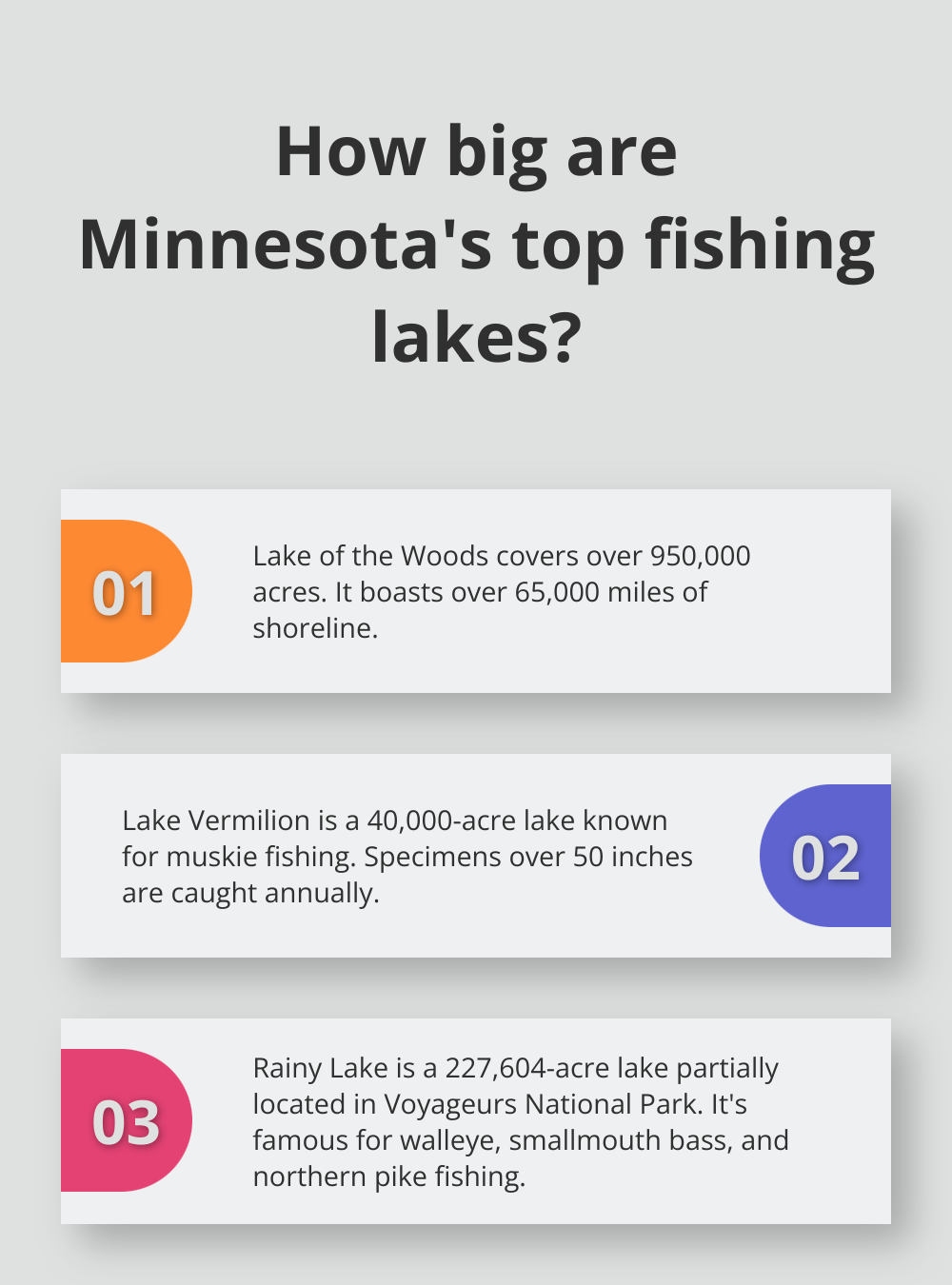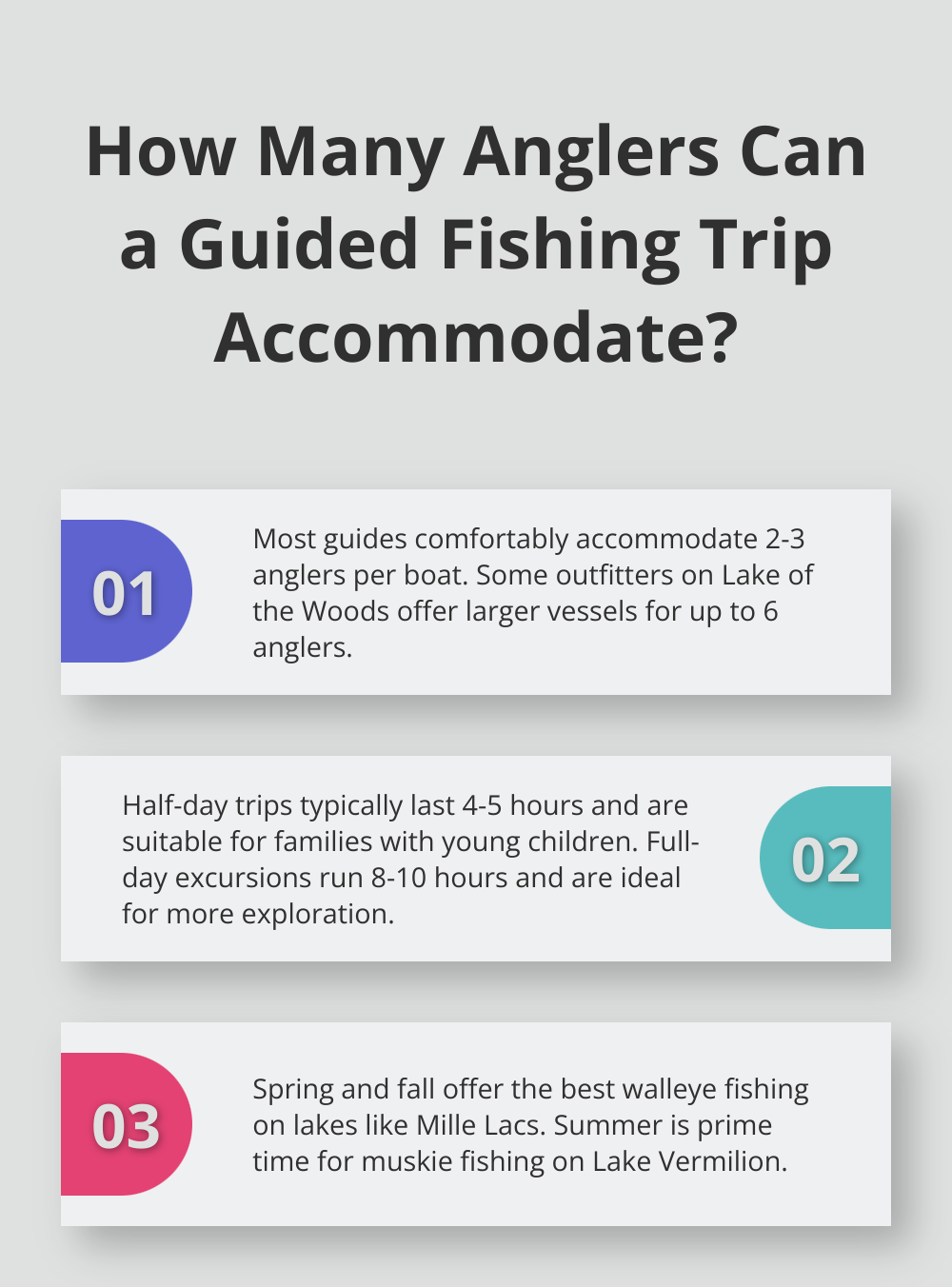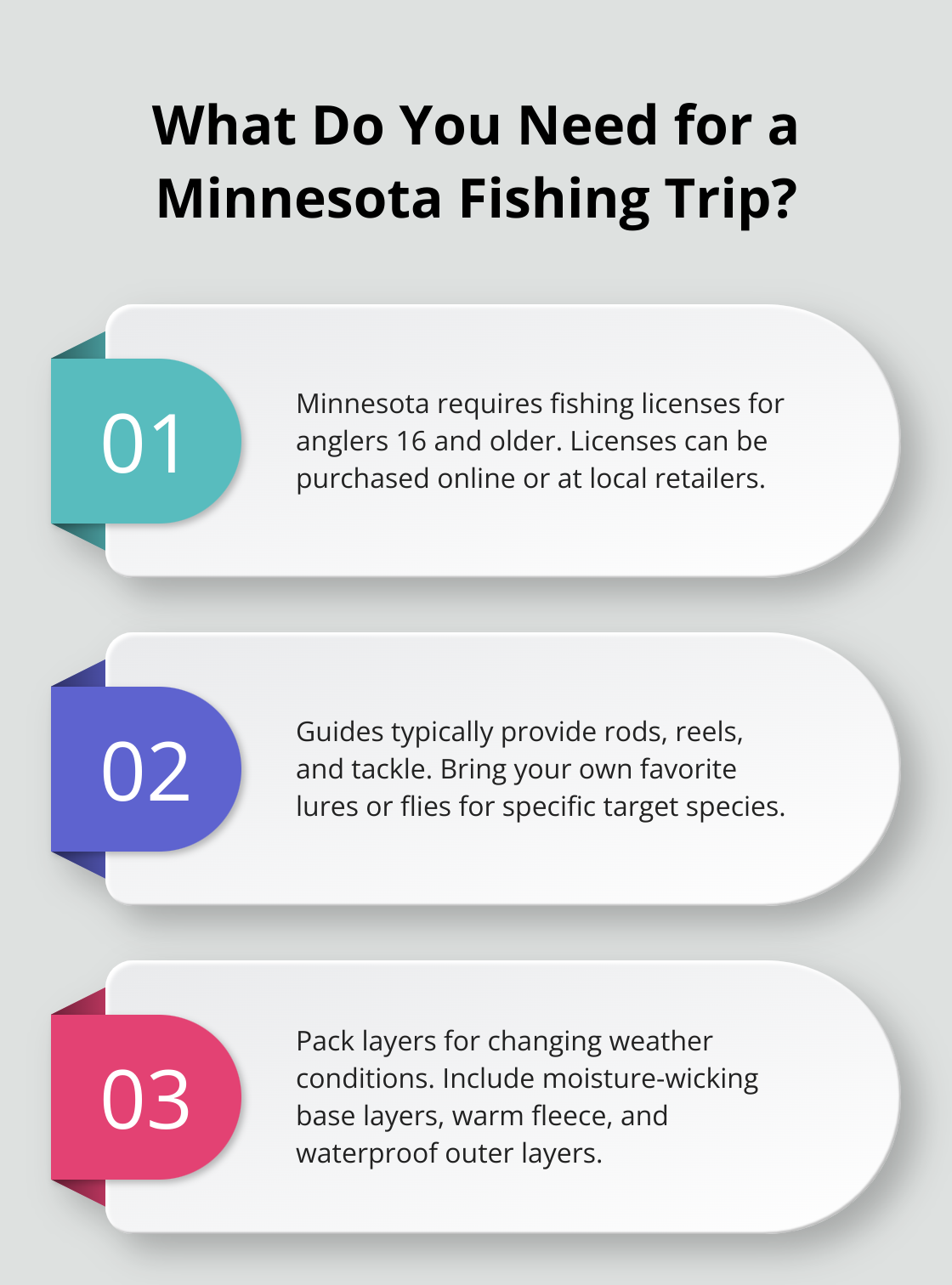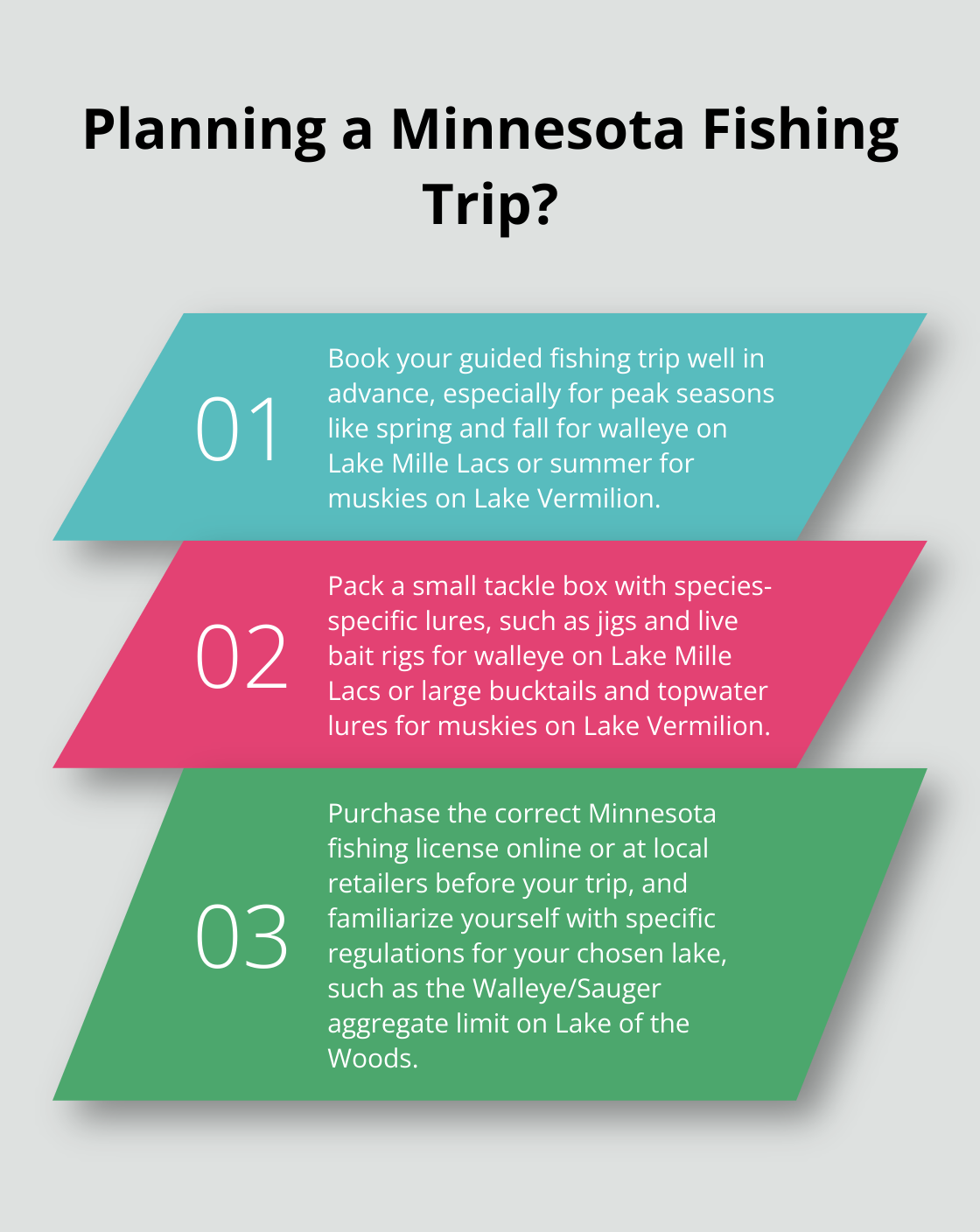Minnesota’s lakes offer some of the best fishing experiences in the country. At Up North Property Management, we’ve seen countless anglers reel in trophy catches and create lasting memories on our state’s pristine waters.
Minnesota guided fishing trips provide an excellent way to explore these world-class fishing destinations, whether you’re a seasoned angler or a novice looking to learn the ropes. In this post, we’ll share expert tips on choosing the right guided trip, essential gear, and the top spots to cast your line.
Where Are Minnesota’s Top Fishing Spots?
Minnesota’s lakes offer some of the best fishing experiences in the country. We’ve identified four top destinations that stand out for their exceptional fishing opportunities and unique characteristics.
Lake Mille Lacs: Walleye Heaven
Lake Mille Lacs reigns as Minnesota’s walleye capital. Walleye catch rates continued increasing to the highest ever observed during the winter of 2023-2024, resulting in a relatively high harvest of Walleye.

May, June, September, and October provide the best walleye action. Hire a local guide to access the most productive spots and learn effective techniques for this lake’s unique ecosystem.
Lake of the Woods: Diverse Fishing Paradise
Lake of the Woods, straddling the U.S.-Canada border, is a multi-species fishing haven. This massive body of water covers over 950,000 acres and boasts over 65,000 miles of shoreline. Anglers can target walleye, sauger, northern pike, and muskellunge year-round.
Winter ice fishing attracts thousands of enthusiasts. For summer fishing, troll with crankbaits or jig in deeper waters for consistent action.
Lake Vermilion: Scenic Beauty Meets Trophy Fish
Lake Vermilion combines breathtaking scenery with excellent fishing opportunities. This 40,000-acre lake is known for its muskie fishing, with specimens over 50 inches caught annually. The lake also offers great walleye, northern pike, and smallmouth bass fishing.
Late summer or early fall provides the best muskie action. Use large lures and focus on weed edges and rocky points for the best chances at a trophy catch. Local bait shops can provide up-to-date information on hot spots and effective lures.
Rainy Lake: Remote Wilderness Experience
Rainy Lake offers a true wilderness fishing experience for those seeking seclusion. This 227,604-acre lake, partially located in Voyageurs National Park, is famous for its walleye fishing but also provides excellent opportunities for smallmouth bass and northern pike.
June and September are prime months for walleye, while July and August are best for smallmouth bass. Consider hiring a guide or renting a houseboat to fully explore this vast lake and its numerous islands.
Fishing regulations can vary across these destinations. Always check the latest Minnesota DNR guidelines and obtain the necessary licenses before your trip. With proper preparation and local knowledge, you’ll set yourself up for an unforgettable fishing experience in Minnesota’s premier lakes. Now, let’s explore how to choose the right guided fishing trip to make the most of these incredible destinations.
How to Choose the Perfect Guided Fishing Trip
Selecting the right guided fishing trip can transform your Minnesota angling experience. A well-chosen guide can turn a good fishing trip into an unforgettable adventure.
Tailoring Your Trip to Your Goals
Consider what you want to achieve. Do you want to catch a specific species like walleye or muskie? Or do you prefer a mixed-bag experience? Some guides specialize in certain fish or techniques, while others offer more versatile trips. On Lake Mille Lacs, guides provide professionally guided smallmouth bass, walleye, and muskie fishing experiences.
Experience Matters
Look for guides with extensive local knowledge. Experienced guides not only know where the fish bite but can also share fascinating insights about the area’s ecology and history. Check online reviews and ask for references to gauge a guide’s reputation.
Group Size and Boat Options
Consider your group size when booking. Most guides accommodate 2-3 anglers comfortably, but larger groups might require multiple boats or a bigger charter. On Lake of the Woods, some outfitters offer larger vessels that can handle up to six anglers, perfect for family outings or corporate trips.
Full-Day vs. Half-Day Trips
Decide on trip duration based on your stamina and goals. Half-day trips (4-5 hours) work well for families with young children or those new to fishing. Full-day excursions (8-10 hours) allow for more exploration and often yield better results, especially on vast waters like Lake Vermilion.
What’s Included?
Clarify what the package includes. Most reputable guides supply all necessary fishing gear, bait, and life jackets. Some even offer fish cleaning services. However, you’ll typically need to bring your own food, drinks, and personal items. Always confirm these details when booking to avoid surprises.
Seasonal Considerations
Timing plays a crucial role in fishing success. Spring and fall often offer the best walleye action on lakes like Mille Lacs, while summer is prime time for muskies on Lake Vermilion. Discuss the best times for your target species with potential guides and book well in advance for peak seasons.

A great guide does more than just put you on fish. They teach techniques, share local knowledge, and ensure a safe, enjoyable experience. These factors will help you select an exceptional Minnesota fishing adventure. Now, let’s explore the essential gear and preparation needed for your guided fishing trip.
What Gear Do You Need for a Minnesota Fishing Trip?
Fishing Equipment Essentials
Most reputable guides in Minnesota provide rods, reels, and tackle. However, you should bring your own favorite lures or flies. Pack a small tackle box with various options suitable for your target species. For walleye fishing on Lake Mille Lacs, include jigs and live bait rigs. If you plan to target muskies on Lake Vermilion, pack some large bucktails and topwater lures.

Don’t forget to bring needle-nose pliers for hook removal and a sharp knife for cutting line. A net is usually provided by the guide, but you can bring your favorite landing net. Sunglasses with polarized lenses help reduce glare and spot fish in the water.
Clothing and Personal Items
Minnesota weather can change quickly, so pack layers. Include moisture-wicking base layers, a warm fleece or sweater, and a waterproof outer layer. Even summer mornings on the water can feel chilly. Bring a hat with a brim to protect your face from the sun and fingerless gloves for early morning starts.
Wear comfortable, non-slip shoes for boat safety (avoid dark-soled shoes that can mark the boat deck). Pack sunscreen with a high SPF, insect repellent, and hand sanitizer. Bring a reusable water bottle to stay hydrated throughout the day.
A waterproof bag or case for your phone and camera will protect your devices from water damage while you capture trophy fish moments. Pack snacks or a lunch unless your guide specifies that food is provided.
Licenses and Regulations
Obtain the correct fishing license before your trip. Minnesota requires all anglers 16 years and older to have a valid fishing license. You can purchase licenses online through the Minnesota Department of Natural Resources website or at various local retailers.
Familiarize yourself with specific regulations for your chosen lake. For example, Lake of the Woods has special regulations for walleye and sauger. The Walleye/Sauger aggregate limit is six (no more than four can be Walleye), and Walleye from 19.5 through 28 inches must be immediately released. On Lake Vermilion, different slot limits apply for northern pike depending on which side of the lake you fish. Your guide should know local regulations, but it’s good to understand them beforehand.
Some species (like trout and salmon) require additional stamps or validations. If you plan to target these fish, purchase the necessary add-ons to your license.
Guide-Provided Equipment
Try to confirm what equipment your guide will provide. Most guides supply basic fishing gear, but policies can vary. Ask about:
- Rods and reels
- Bait and tackle
- Life jackets (required by law)
- Fish finders or other electronics
- Ice fishing shelters (for winter trips)
Optional Items to Consider
While not essential, these items can enhance your fishing experience:
- Camera (waterproof or with a waterproof case)
- Binoculars for spotting wildlife
- Cooler for drinks and snacks (if not provided)
- First aid kit (for minor injuries)
- Hand warmers (for early spring or late fall trips)
Final Thoughts
Minnesota guided fishing trips offer world-class experiences for anglers of all skill levels. Expert guides know where to find fish, share local knowledge, teach effective techniques, and ensure safety on the water. They provide necessary equipment and adapt to changing conditions, which maximizes your chances of a successful outing.

A guided trip blends education and excitement, whether you seek a trophy muskie or want to learn walleye fishing basics. You’ll gain insights into fish behavior, learn about local ecosystems, and potentially discover new favorite fishing spots. For those looking to extend their stay, Up North Property Management offers exceptional vacation rentals in the Northern Lakes Area.
Secure your license, prepare your gear, and get ready to cast your line into Minnesota’s bountiful waters. The fish await, and with a guided trip, you move one step closer to the catch of a lifetime (and unforgettable memories).
